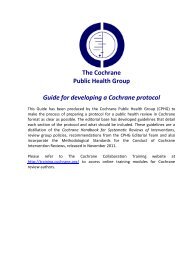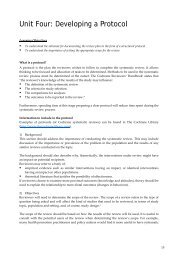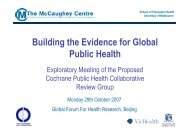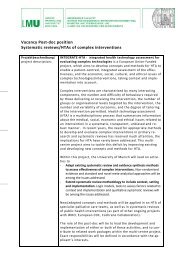Unit Eight: Principles of Critical Appraisal - Cochrane Public Health ...
Unit Eight: Principles of Critical Appraisal - Cochrane Public Health ...
Unit Eight: Principles of Critical Appraisal - Cochrane Public Health ...
Create successful ePaper yourself
Turn your PDF publications into a flip-book with our unique Google optimized e-Paper software.
ADDITIONAL READING<br />
Rychetnik L, Frommer M, Hawe P, Shiell A. Criteria for evaluating evidence on public health<br />
interventions. J Epidemiol Community <strong>Health</strong> 2000;56:119‐27.<br />
Kahan B, Goodstadt M. The IDM Manual for Using the Interactive Domain Modal Approach to Best<br />
Practices in <strong>Health</strong> Promotion.<br />
www.utoronto.ca/chp/bestp.html#Outputs/Products<br />
Guyatt GH, Sackett DL, Cook DJ, for the Evidence‐Based Medicine Working Group. Users’ Guides to<br />
the Medical Literature. II. How to Use an Article About Therapy or Prevention. A. Are the Results <strong>of</strong><br />
the Study Valid? Evidence‐Based Medicine Working Group. JAMA 1993;270(21):2598‐2601.<br />
Notes on terms/statistics used in primary studies: Adapted from the <strong>Cochrane</strong> Reviewers’<br />
Handbook Glossary, Version 4.1.5. Available at www.cochrane.org/resources/handbook/glossary.pdf<br />
Bias<br />
A systematic error or deviation in results. Common types <strong>of</strong> bias in health promotion and public<br />
health studies arise from systematic differences in the groups that are compared (allocation bias), the<br />
exposure to other factors apart from the intervention <strong>of</strong> interest (eg. contamination), withdrawals<br />
from the study (attrition bias), assessment <strong>of</strong> outcomes (detection bias), including data collection<br />
methods, and inadequate implementation <strong>of</strong> the intervention.<br />
Blinding<br />
Keeping secret group assignment (intervention or control) from the study participants or<br />
investigators. Blinding is used to protect against the possibility that knowledge <strong>of</strong> assignment may<br />
affect subject response to the intervention, provider behaviours, or outcome assessment. The<br />
importance <strong>of</strong> blinding depends on how objective the outcome measure is; blinding is more<br />
important for less objective measures.<br />
Confidence Interval (CI)<br />
The range within with the ‘true’ value (eg. size <strong>of</strong> effect <strong>of</strong> the intervention) is expected to lie within a<br />
given degree <strong>of</strong> certainty (eg. 95%). It is about the precision <strong>of</strong> the effect. CI’s therefore indicate the<br />
spread or range <strong>of</strong> values which can be considered probable. The narrower the CI the more precise<br />
we can take the findings to be.<br />
Confounding<br />
A situation in which the measure <strong>of</strong> the effect <strong>of</strong> an intervention or exposure is distorted because <strong>of</strong><br />
the association <strong>of</strong> exposure with other factors that influence the outcome under investigation.<br />
Intention to treat<br />
An intention‐to‐treat analysis is one in which all the participants in the trial are analysed according to<br />
the intervention to which they are allocated, whether they received it or not.<br />
Odds ratios<br />
The ratio <strong>of</strong> the odds <strong>of</strong> an event (eg. prevention <strong>of</strong> smoking, unintended pregnancy) in the<br />
intervention group to the odds <strong>of</strong> an event in the control group.<br />
56








